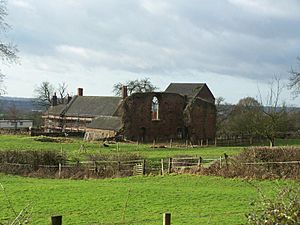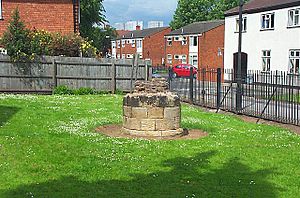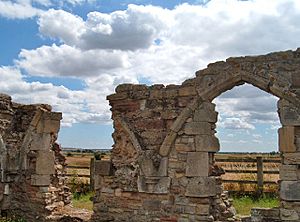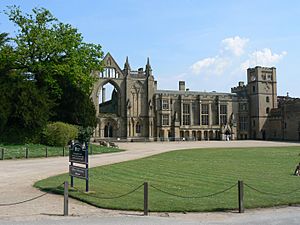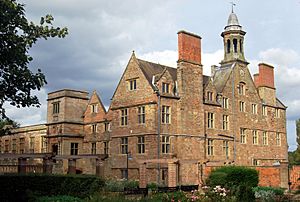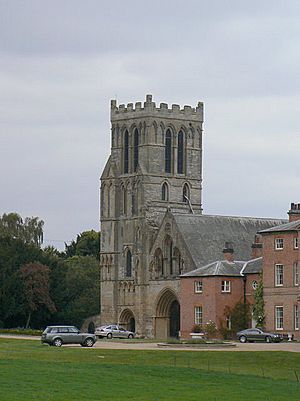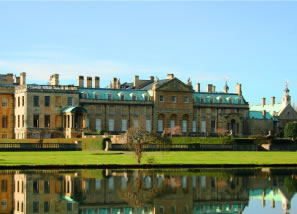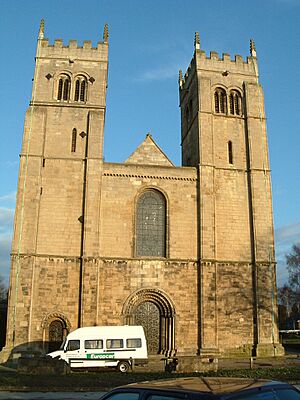List of monastic houses in Nottinghamshire facts for kids
This article is about the monastic houses in Nottinghamshire, England. Monastic houses were special places where groups of religious people, like monks or nuns, lived together. They dedicated their lives to prayer, study, and work. These places were often called priories, abbeys, or friaries, depending on the type of religious order that lived there.
In Nottinghamshire, many of these houses were built centuries ago. They played an important role in local communities before they were closed down, mostly in the 1500s. This happened during a time known as the Dissolution of the Monasteries, when King Henry VIII of England made big changes to religious life in England.
Contents
Types of Monastic Houses
There were different kinds of religious groups living in these houses:
- Monks lived in monasteries or abbeys. They followed strict rules and often lived away from towns.
- Nuns lived in convents or priories, similar to monks but for women.
- Canons were priests who lived in communities, often serving a church.
- Friars were different from monks because they often lived in towns and went out to preach and help people.
Many of these places were "founded" (started) by wealthy people or kings. When they were "dissolved," it meant they were closed down, and their buildings and lands were taken by the Crown (the king or queen). Sometimes, the buildings were destroyed, but often parts were used for new houses or churches.
Important Monastic Sites in Nottinghamshire
Here are some of the key monastic houses that once existed in Nottinghamshire:
Beauvale Priory
Beauvale Charterhouse was a home for Carthusian monks. These monks lived very strict, quiet lives. It was founded in 1343 by Nicholas de Cauntlow. The priory was dedicated to the Holy Trinity and Saint Mary the Virgin with All Saints. It was closed down in 1539.
Blyth Priory
Blyth Priory was a home for Benedictine monks. It was founded in 1088 by Roger de Builly. For a long time, it was an "alien house," meaning it was controlled by a larger monastery in Rouen, France. Later, it became "denizen," which meant it became independent. The priory was dissolved in 1536, but its church is still used by the local community today.
Felley Priory
Felley Priory housed Augustinian Canons Regular. It started around 1152 as a small church and hermitage connected to Worksop Priory. By 1260, it became independent. This priory was closed in 1536.
Fiskerton Cell
Fiskerton Cell was likely a small chapel or a very small monastic house, possibly served by Augustinian Canons Regular from Thurgarton Priory. It was founded around 1139.
Lenton Priory
Lenton Priory was home to Cluniac monks. It was founded between 1102 and 1108 by William Peverell. Like Blyth, it was an "alien house" connected to the famous Cluny Abbey in France, but it became independent in 1392. It was dissolved in 1538.
Mattersey Priory
Mattersey Priory was a home for Gilbertine Canons. This was a unique English religious order. It was founded around 1185. Sadly, a fire destroyed much of it in 1279. The priory was dissolved in 1538, and its ruins are now looked after by English Heritage.
Newark Greyfriars
Newark Greyfriars was a friary for Observant Franciscan Friars, founded around 1507, possibly by King Henry VII of England. It was dissolved in 1534. Later, Augustinian Friars took it over, but it was dissolved again in 1539. A house called 'The Friary' was later built on its site.
Newstead Priory
Newstead Priory was founded around 1163 by King Henry II of England for Augustinian Canons Regular. It was dissolved in 1539. After it closed, it was turned into a grand house known as Newstead Abbey. The famous poet George Gordon Byron (Lord Byron) lived here and restored parts of it around 1800. Today, it belongs to Nottingham City Council.
Nottingham Friaries
Nottingham had several friaries:
- Nottingham Greyfriars: This was a home for Franciscan Friars Minor, founded before 1230. It was dissolved in 1539.
- Nottingham Whitefriars: This was for Carmelite Friars, founded before 1271. It was dissolved in 1539.
Ossington Preceptory
Ossington Preceptory was a base for the Knights Hospitaller. This was a military religious order that helped pilgrims and defended Christian lands. It was founded before 1154. The site of their church is probably where the Holy Rood church was built in 1782.
Rufford Abbey
Rufford Abbey was a Cistercian monastery, founded in 1136. Cistercian monks were known for their simple lives and often built their abbeys in remote areas. It was dissolved in 1536. Today, it's a country house owned by Nottinghamshire County Council.
Shelford Priory
Shelford Priory was for Augustinian Canons Regular, founded during the reign of King Henry II. It was dissolved in 1536. Parts of the priory were used to build 'Shelford House', which was later rebuilt after a fire.
Thurgarton Priory
Thurgarton Priory was home to Augustinian Canons Regular. It was founded between 1119 and 1139. The priory was dissolved in 1538. Parts of its church are still used as a local church today.
Wallingwells Priory
Wallingwells Priory was a priory for Benedictine nuns, founded around 1130-1144. It was dissolved in 1539. Some parts of the priory might be included in the Wallingwells Hall, a country house built much later.
Welbeck Abbey
Welbeck Abbey was a monastery for Premonstratensian Canons, founded in 1153. It was dissolved in 1538. The remains of the abbey were later made into a large private home, which has been changed and rebuilt over the years.
Worksop Priory
Worksop Priory was for Augustinian Canons Regular, founded after 1119. It was dissolved in 1538. Like some other priories, its church is still used by the local community today. It was once known as Radford Priory.
Images for kids
See also


